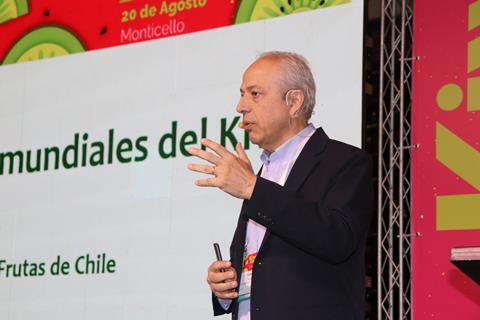Event looked at how the sector can continue to improve the quality and consistency of the country’s kiwifruit offer
Almost 500 producers and exporters took part in Chile’s first-ever Kiwi Day this week. The event, organised by the Chilean Kiwifruit Committee and RedAgrícola, was an opportunity for the sector to analyse the challenges its faces to improve the quality of its kiwifruit offer and make the industry more commercially and economically sustainable.

Kiwifruit Committee president Carlos Cruzat said Chile must improve the quality of its green kiwifruit if it is to compete at a global level. “We have New Zealand that offers a very good product, which is increasing its supply of yellow kiwifruit and decreasing its supply of green fruit. The Europeans harvest later and arrive in good condition, therefore, we have to work to deliver a great product,” he said.
Regarding the new varieties, Cruzat noted: “There we have a more complex challenge, which has to do with all the difficulties we have faced to maintain the plantations successfully. We have been testing new varieties for 20 years, so, to move forward in facing this problem we have to work together. What comes next is that we share that information and prepare ourselves so that these new varieties become successful.”
Ignacio Caballero, marketing director of Frutas de Chile, highlighted the need to better understand the consumer and where they get their information. He said the digital revolution had transformed the way people consume, and that social media has created a great opportunity to reach different types of consumers, particularly young consumers.
Caballero also stressed the importance of maintaining and strengthening promotional actions. He pointed out that Chile invests around US$390,000 to market its kiwifruit internationally, while Zespri’s promotional budget exceeded US$100m.
Global and National Kiwi Scenario
In his analysis of the global kiwifruit scenario, Jean Baptiste Pinel of Primland France said the fall in production created both opportunities and challenges for Chilean kiwifruit.
He said: “Chile has made a good decision to fight not to harvest early fruit, to accumulate more brix, which is appropriate. I know that it is more attractive to harvest early because you can get better prices, but the consumer will not return after a bad experience.”
He said Chile could set the benchmark in green kiwifruit, provided the quality is right.
At the same time, he noted that “Chile must definitely explore new varieties, especially in yellow kiwifruit, since the world is going in that direction”.
Álvaro Herreros, deputy manager of Garcés Fruit, said that the entry of new players like Iran made it more important than ever for Chile to focus on quality.
“The industry has a short-term view, where for example we do not know what the client from Brazil or other markets wants. We are so busy chasing clients that we are not building a brand. We are not listening to the real needs of consumers and we are not transmitting those needs to producers to develop this fruit,” he observed.
“The time to invest is today, because we are going to compete with more green and yellow kiwifruit. We need to renew the industry now, and not regret it later without knowing what to do. We have to have the best possible fruit, well developed in the field, because the packhouse is not a hospital.”
New Zealand Experience and Postharvest
Is it possible to replicate the New Zealand experience in Chile? That was the question that postharvest experts María Paz Márquez of Greenvic and Graciela Valdés of David del Curto sought to answer during their presentation.
Based on observations from the recent visit to New Zealand organised by the Kiwifruit Committee and Zespri, Márquez said: “In New Zealand, producers have an average of 3.8ha of kiwifruit, compared to Chile, where producers have an average of 14.3ha. In New Zealand, the producer is small but specialises in kiwifruit and is dedicated only to this crop, unlike in Chile, where producers also produce other fruit crops”.
Márquez and Valdés agreed that Chile could adopt certain New Zealand practices, simplifying some processes, such as packaging. But they stressed that progress must be made in improving the quality, consistency and appearance of the fruit.
Dr Juan Pablo Zoffoli pointed out that in order to improve the quality of its kiwifruit, it would be “more important to pay producers for dry matter than for size”.
Research and Development for the benefit of the sector
During the event, delegates were told about the committee’s new Kiwifruit Management Platform, a free service for the entity’s members that integrates critical information for decision-making by producers and exporters.
Elizabeth Köhler, the committee’s technical advisor, said the tool is “a place where it is possible to access all the standardised and validated information for producers, exporters, advisors and professionals in the sector”.
In addition, the possibility of producing new genetics in the country was addressed. In this regard, Cherie Méndez, project management supervisor of the Kiwifruit Committee, presented the results of the Corfo project setting out protocols and selection methodologies for the establishment of genetic material of Actinidia sp. for commercial use in Chile.
She said new varieties have not had good results in Chile, a problem that this project faces in order to offer national production alternatives to the predominant green Hayward variety. The recommendations are already available in a committee publication that will be published on its website.
Regarding the possibility of adopting new varieties in the country, Jordi Casas, technical director of Caducos, commented that “the development of new varieties will come to us no matter what. The same thing happened to us with apples and stonefruit, and today we have a few years to be aware of the new varieties, where we have to join forces to get to know them, in green varieties but also not to leave aside the yellow or red ones”.



